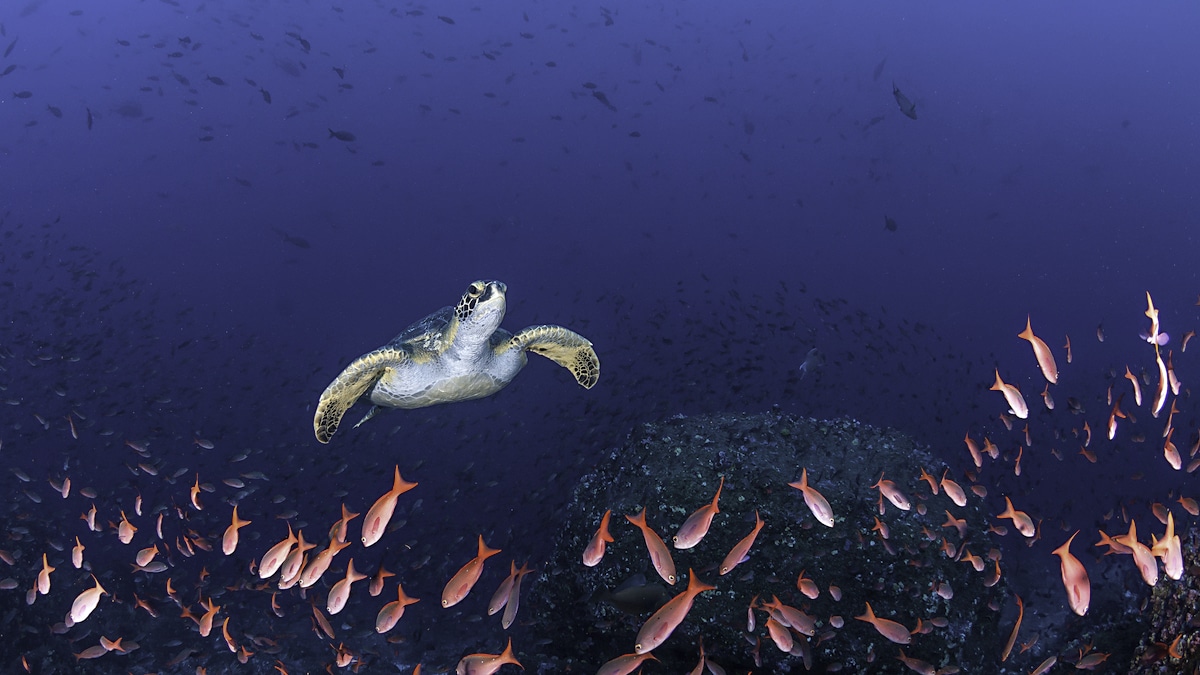

A volcanic mountain landscape with lava plateaus and white coral sand beaches rimmed with blue-green sea, the Galápagos archipelago is inhabited by more than 180 species found nowhere else on Earth. The first recorded visitor to the group of islands was Tomás de Berlanga, fourth Bishop of Panama, who happened upon it on his way to Peru in 1535. Insulae de los de Galopegos, or “Islands of the Tortoises,” as it was named in the 1570 world atlas of Flemish cartographer Abraham Ortelius, has been capturing the imagination of scientists and visitors ever since.
Recently, Ecuador created an extensive new marine reserve north of the Galápagos islands to protect sea turtles, sharks and other migratory species. The new reserve, called Hermandad, which means “brotherhood” in Spanish, forms a Pacific corridor as far as Cocos Island National Park in Costa Rica, Phys.org reported. The reserve adds more than 20,000 square miles to the already existing 50,200-square-mile Galápagos Marine Reserve that has been protected since 1998.
Ecuador’s President Guillermo Lasso said the creation of the Hermandad Marine Reserve is a “clear message for the world,” and described it as a “new relationship with the Earth, a new understanding of what constitutes progress for humanity,” reported Phys.org.
President Lasso celebrated the opening of the Hermandad Marine Reserve with a ribbon-cutting ceremony using ribbon made from materials gathered during coastal cleanups in the Galápagos. Plans are being made by authorities for additional protected areas in Panama and Colombia, which would create an international marine biosphere reserve.
In 1835, English naturalist Charles Darwin disembarked from the sailing ship H. M. S. Beagle, captained by Robert FitzRoy on its return trip across the Pacific after a charting voyage around South America. In September and October of that year, Darwin explored four of the more than a dozen major islands of the Galápagos — San Cristóbal, Floreana, Isabela and Santiago — where he collected specimens.
Darwin’s discoveries in the Galápagos were of great importance in the development of his Theory of Evolution by Natural Selection. According to the Galápagos Conservation Trust, Darwin said, “… by far the most remarkable feature in the natural history of this archipelago… is that the different islands to a considerable extent are inhabited by a different set of beings…”
The Galápagos archipelago is a Natural World Heritage Site that is home to more than 2,900 marine species, reported Phys.org. There is a prohibition on industrial fishing in the Galápagos Marine Reserve, which is the second-largest in the world.
“The Ecuadorian government announced its decision to create the new reserve at COP26 in Glasgow in order to focus the eyes of the world on the need to protect our oceans,” Ecuador’s Ministry of the Environment, Water and Ecological Transition said in a statement emailed to EcoWatch. “However, technically the proposal had been worked on for several years based on scientific confirmation of an underwater mountain range that threatened migratory species use in their route, also known as the migravía, between the Galápagos and Cocos Island.”
According to the Galápagos Conservancy, many of the species found in the Galápagos islands are endemic — that is, they are found nowhere else on Earth. In fact, about 80 percent of the land birds and 97 percent of the land mammals and reptiles are unique to the islands, as are more than 30 percent of the flora and more than 20 percent of the marine animal species. These include the Galápagos penguin — the only species of penguin found in the Northern Hemisphere — the flightless cormorant, the marine iguana and the Galápagos giant tortoise.
“The new Hermandad Marine Reserve is a biological corridor for more than 20 migratory species that face different levels of threat, such as sharks, sea turtles, manta rays, etc.,” Ecuador’s Ministry of the Environment, Water and Ecological Transition said in the statement to EcoWatch. “They are species that travel between the two protected areas: the Galápagos and Cocos Island (Costa Rica). They head through this space following the underwater mountain range that provides them with food. Some Galápagos species have been found in this area, such as sea lions, albatrosses and Galápagos sharks that leave the archipelago to feed.”
President of Columbia Ivan Duque, who attended the dedication event, expressed that the eventual joining of the Malpelo islands of Columbia and the Coiba islands of Panama with the marine reserve would benefit the migration of species, as Phys.org reported. He also stated that the new reserve would ensure the survival of 40 percent of the marine species in the world.
“We may be a small territory… but the planet is also ours,” President Lasso said, reported Phys.org.
“The seas are great regulators of the global climate… taking care of them is not naive idealism, it is a vital necessity,” Lasso said.

 233k
233k  41k
41k  Subscribe
Subscribe 